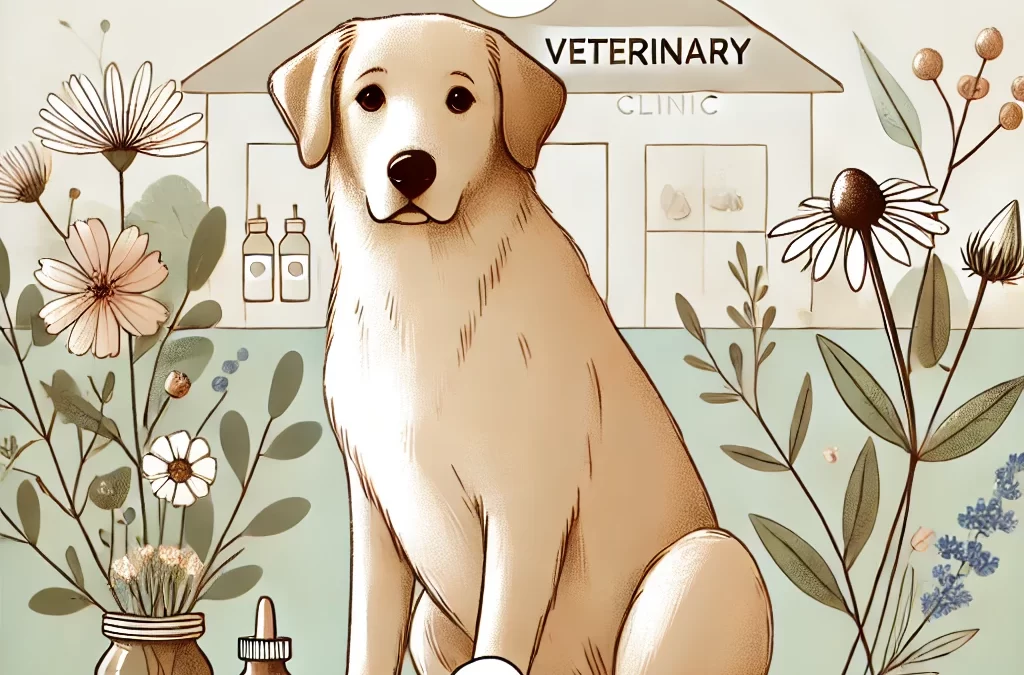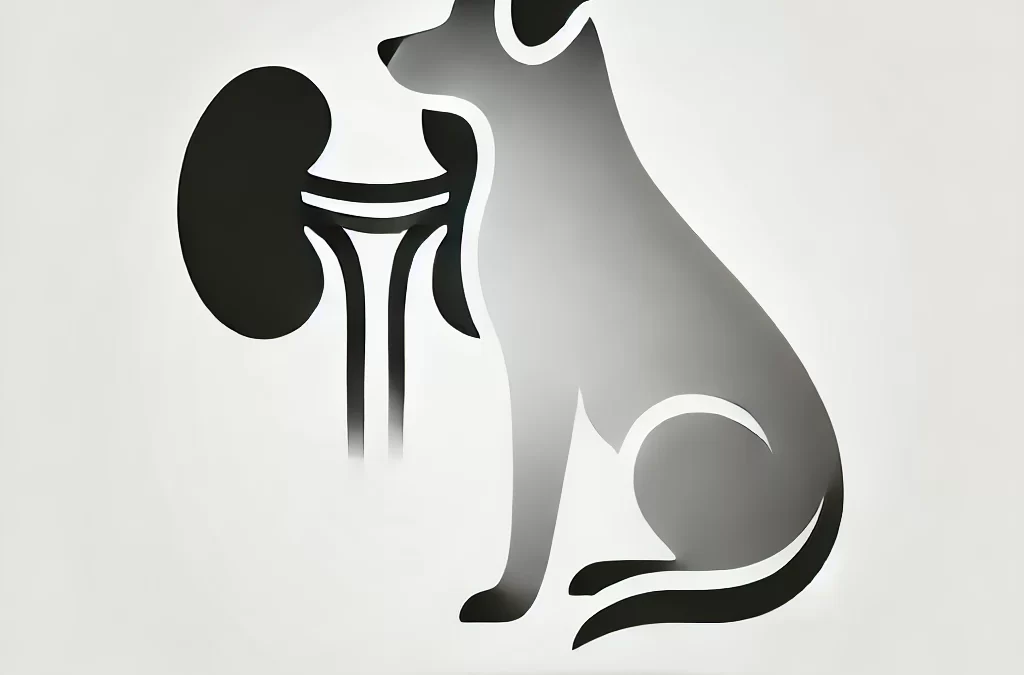
utworzone przez TCMVET | gru 3, 2024 | Rak i guzy u psów
Hemangiopericytoma to rzadki guz tkanki miękkiej u psów, powstający z perycytów, komórek otaczających naczynia krwionośne. Chociaż te guzy rosną zazwyczaj powoli i są zlokalizowane, ich tendencja do nawrotów po chirurgicznym usunięciu sprawia, że stanowią wyjątkowe wyzwanie w onkologii weterynaryjnej. W tym artykule zagłębiamy się w naturę hemangiopericytoma, ich diagnozę i przełomowe sposoby skutecznego leczenia.
Czym jest hemangiopericytoma u psów?
Hemangiopericytomy występują zazwyczaj w skórze lub tkankach podskórnych u psów w średnim i starszym wieku. Guzy te mogą wyglądać następująco:
- Twarde, ruchome grudki pod skórą
- Guzy o różnej wielkości, czasami owrzodzone, jeśli znajdują się na powierzchni
- Powolnie postępujące, ale inwazyjne narośla
Guzy te są zazwyczaj umiejscowione na kończynach i rzadko dają przerzuty, jednak mogą znacząco utrudniać poruszanie się i ograniczać komfort życia psa.
Nietypowe znaki, na które należy zwrócić uwagę
Chociaż hemangiopericytoma może początkowo wydawać się niegroźna, pewne objawy powinny wzbudzić niepokój:
- Uporczywe lizanie lub gryzienie guza
- Obrzęk, który nie ustępuje
- Miejscowa kulawizna lub dyskomfort
Te subtelne objawy często poprzedzają bardziej oczywiste oznaki rozwijającego się guza.
Innowacyjne podejścia do diagnozy
Tradycyjne metody diagnostyczne obejmują aspirację cienkoigłową lub biopsję, a następnie obrazowanie, takie jak zdjęcia rentgenowskie lub USG. Jednak postęp w diagnostyce weterynaryjnej pozwala obecnie na:
- Skany CT:Zapewnia szczegółowe obrazy zasięgu guza.
- Modelowanie guzów 3D:Służy do planowania precyzyjnych interwencji chirurgicznych.
- Biopsje płynne:Nowoczesna metoda wykrywania specyficznych dla nowotworów markerów we krwi, umożliwiająca nieinwazyjne monitorowanie.
Przemyślenie opcji leczenia
Chociaż złotym standardem w leczeniu hemangiopericytoma pozostaje leczenie chirurgiczne, pojawiają się innowacyjne metody mające na celu poprawę wyników:
- Zaawansowane techniki chirurgiczne:Chirurgia laserowa i elektrochirurgia zmniejszają ryzyko nawrotu choroby dzięki uzyskaniu czystszych marginesów.
- Immunoterapia:Stymulacja układu odpornościowego w celu zwalczania pozostałych komórek nowotworowych po operacji.
- Krioterapia:Zamrożenie komórek nowotworowych w celu miejscowego leczenia, gdy zabieg chirurgiczny jest niemożliwy.
- Terapia fotodynamiczna:Wykorzystywanie leków aktywowanych światłem w celu niszczenia komórek rakowych.
Te nowatorskie podejścia oferują alternatywę w przypadkach, w których tradycyjna operacja może być nieskuteczna lub utrudniona.
Terapie naturalne i wspomagające
Holistyczna opieka zyskuje na popularności jako uzupełnienie konwencjonalnych metod leczenia. Należą do nich:
- Suplementy ziołowe:Składniki takie jak astragalus i grzyby lecznicze wspomagają odporność i potencjalnie hamują rozwój guza.
- Akupunktura:Pomaga złagodzić ból i poprawić ogólne samopoczucie.
- Olejek CBD:Znany ze swoich właściwości przeciwzapalnych i przeciwbólowych, może pomóc psom radzić sobie z dyskomfortem.
W połączeniu z odpowiednim odżywianiem i regularnymi ćwiczeniami, terapie te przyczyniają się do poprawy jakości życia.
Siła opieki paliatywnej
W przypadku psów z zaawansowanymi lub nawracającymi hemangiopericytomami opieka paliatywna koncentruje się na komforcie:
- Leczenie bólu za pomocą leków lub terapii laserowej
- Pomoce w poruszaniu się, takie jak uprzęże lub wózki inwalidzkie
- Wzbogacenie emocjonalne w celu utrzymania zdrowia psychicznego
Właściciele często znajdują ukojenie w świadomości, że zapewniają swojemu zwierzęciu miłość i opiekę w trudnych chwilach.
Dlaczego hemangiopericytomy są wyzwaniem dla innowacji
Hemangiopericytomy stanowią wyzwanie dla lekarzy weterynarii i właścicieli zwierząt domowych, aby myśleli poza konwencjonalnymi metodami leczenia. Niski potencjał przerzutowy zapewnia wyjątkową okazję do eksperymentowania z ukierunkowanymi terapiami i holistycznymi podejściami bez narażania jakości życia psa.
Dzięki wykorzystaniu nowych technologii i zintegrowanej opieki leczenie hemangiopericytomów może stać się bardziej spersonalizowanym i skutecznym procesem, dającym psom szansę na komfortowe i satysfakcjonujące życie.

utworzone przez TCMVET | gru 3, 2024 | Rak i guzy u psów
Rak kręgosłupa u psów to rzadki, ale krytyczny stan, który wpływa na kręgosłup lub rdzeń kręgowy, potencjalnie prowadząc do wyniszczających objawów. Podczas gdy tradycyjne podejścia weterynaryjne często obejmują operację, radioterapię lub chemioterapię, istnieje rosnący ruch w kierunku terapii integracyjnych i naturalnych, które stawiają na pierwszym miejscu jakość życia. W tym artykule omówiono wyjątkowe wyzwania związane z rakiem kręgosłupa u psów i przedstawiono alternatywne perspektywy dotyczące leczenia.
Czym jest rak kręgosłupa u psów?
Rak kręgosłupa występuje, gdy nieprawidłowe komórki rosną niekontrolowanie w kręgosłupie, wpływając na kości, nerwy lub otaczające tkanki. Typowe typy obejmują:
- Kostniakomięsak:Dotyczy kości kręgosłupa.
- Chłoniak:Może naciekać rdzeń kręgowy lub kręgi.
- Nowotwory:Guz uciskający rdzeń kręgowy lub nerwy.
W zależności od umiejscowienia nowotwory te mogą powodować ból, trudności w chodzeniu, paraliż lub nietrzymanie moczu.
Nietypowe objawy, na które należy zwrócić uwagę
Wczesne objawy raka kręgosłupa są często subtelne i mogą przypominać inne schorzenia:
- Przenoszenie ciężaru ciała lub faworyzowanie jednej strony podczas chodzenia
- Zmiana postawy, np. wygięcie pleców
- Wrażliwość na dotyk wzdłuż kręgosłupa
Choć wskaźniki te nie są ostateczne, wymagają natychmiastowej interwencji lekarza weterynarii.
Nowe spojrzenie na diagnozę i prognozę
Konwencjonalne metody diagnostyczne, takie jak prześwietlenia rentgenowskie, MRI i biopsje, mogą potwierdzić obecność raka kręgosłupa, ale są inwazyjne i kosztowne. W niektórych przypadkach prognozy mogą być ponure, co skłania wielu właścicieli zwierząt domowych do poszukiwania mniej inwazyjnych i bardziej holistycznych podejść. Zrozumienie konkretnego stanu psa, ogólnego stanu zdrowia i jakości życia jest niezbędne do określenia najlepszej drogi naprzód.
Podejścia integracyjne i naturalne
Innowacyjne podejścia zyskują popularność wśród właścicieli zwierząt domowych i weterynarzy, którzy chcą uzupełnić lub zastąpić tradycyjne metody leczenia. Należą do nich:
- Akupunktura:Pomaga w radzeniu sobie z bólem i poprawia funkcjonowanie nerwów.
- Ziołowe środki zaradczeSkładniki takie jak kurkuma i boswellia mogą zmniejszać stany zapalne i spowalniać wzrost guza.
- Olejek CBD:Zyska popularność dzięki swoim właściwościom przeciwbólowym i przeciwzapalnym.
W połączeniu z odpowiednim odżywianiem, umiarkowanymi ćwiczeniami i otoczeniem wolnym od stresu, terapie te mogą znacznie poprawić komfort i samopoczucie psa.
Siła opieki paliatywnej
W przypadku psów z zaawansowanym rakiem kręgosłupa opieka paliatywna koncentruje się na leczeniu objawów, a nie na leczeniu choroby. Obejmuje to:
- Leki łagodzące ból i stan zapalny
- Fizjoterapia w celu poprawy mobilności
- Wsparcie emocjonalne w celu utrzymania silnej więzi ze swoim pupilem
Wielu właścicieli zwierząt domowych uważa, że stawianie komfortu ponad agresywne traktowanie skutkuje szczęśliwszym i spokojniejszym życiem ich czworonożnych przyjaciół.
Nadzieja dla psów z rakiem kręgosłupa
Chociaż diagnoza raka kręgosłupa jest przerażająca, nie musi oznaczać końca nadziei. Poprzez eksplorację alternatywnych terapii i skupienie się na jakości życia, właściciele zwierząt domowych mogą zapewnić swoim psom miłość i opiekę, na jaką zasługują. Podróż każdego psa jest wyjątkowa, a przemyślane podejście może mieć ogromne znaczenie.
utworzone przez TCMVET | gru 2, 2024 | Rak i guzy u psów
Mięsak kościopochodny to powszechny, ale agresywny nowotwór kości u psów, często związany z silnym bólem i kulawizną. Jednak ciężki oddech jest mniej omawianym objawem, który może pojawić się w zaawansowanych przypadkach, co powoduje, że wielu właścicieli zwierząt domowych jest zdezorientowanych i zaniepokojonych. W tym artykule omówiono potencjalne przyczyny ciężkiego oddechu u psów z mięsakiem kościopochodnym i przedstawiono wskazówki dotyczące radzenia sobie z tym niepokojącym objawem.
Dlaczego występuje ciężki oddech?
U psów z mięsakiem kości może wystąpić trudności w oddychaniu z kilku powodów, w tym:
1. Ból i dyskomfort
Mięsak kości jest bolesnym schorzeniem, zwłaszcza gdy guz rośnie lub daje przerzuty. Ból może prowadzić do zwiększonej częstości oddechów, gdy organizm walczy o radzenie sobie ze stresem. Ciężki oddech w tym kontekście jest często oznaką dyskomfortu.
2. Przerzuty do płuc
W zaawansowanych stadiach kostniakomięsak często rozprzestrzenia się do płuc. Przerzuty do płuc mogą powodować trudności w oddychaniu, kaszel lub świszczący oddech z powodu zmniejszonej pojemności płuc i wymiany tlenu.
3. Skutki uboczne leków przeciwbólowych
Wielu psom z kostniakomięsakiem przepisuje się leki przeciwbólowe, takie jak opioidy lub niesteroidowe leki przeciwzapalne (NLPZ). Leki te, choć konieczne, mogą czasami wpływać na wzorce oddechowe.
4. Lęk lub stres
Przewlekły ból i emocjonalny wpływ choroby mogą sprawić, że pies będzie niespokojny, co doprowadzi do dyszenia lub ciężkiego oddechu. Psy często używają oddechu jako sposobu na komunikowanie niepokoju.
5. Powikłania wtórne
Stany takie jak wysięk opłucnowy (płyn wokół płuc) lub niedokrwistość z powodu przewlekłej choroby mogą również przyczyniać się do utrudnionego oddychania. Oba problemy mogą pojawić się jako wtórne powikłania kostniakomięsaka lub jego leczenia.
Kiedy należy się martwić
Ciężkiego oddechu nie należy ignorować, zwłaszcza jeśli towarzyszą mu:
- Letarg lub niechęć do ruchu.
- Kaszel lub świszczący oddech.
- Niebieskawe zabarwienie dziąseł i języka, wskazujące na niski poziom tlenu.
- Gwałtowne pogorszenie ogólnego stanu zdrowia.
Objawy te mogą być sygnałem, że konieczna jest pilna interwencja lekarza weterynarii.
Co można zrobić, aby pomóc?
1. Leczenie bólu
Skuteczna kontrola bólu jest niezbędna. Skonsultuj się z lekarzem weterynarii w sprawie dostosowania leków lub włączenia alternatywnych terapii, takich jak akupunktura lub olej CBD, aby zmniejszyć dyskomfort.
2.Tlenoterapia
W przypadku przerzutów do płuc lub wysięku opłucnowego, tlen uzupełniający może pomóc ułatwić oddychanie. Przenośne komory tlenowe lub zabiegi w klinice mogą przynieść ulgę.
3. Monitoruj poziom stresu
Stwórz spokojne i komfortowe środowisko dla swojego psa. Stosuj delikatne masaże, uspokajające feromony lub przepisane leki przeciwlękowe, aby zmniejszyć stres.
4. Opieka paliatywna
Jeśli stan Twojego psa jest zaawansowany, opieka paliatywna może koncentrować się na utrzymaniu jakości życia. Może to obejmować radzenie sobie z objawami, a nie stosowanie agresywnych metod leczenia.
5. Ocena weterynaryjna
Zawsze skonsultuj się z weterynarzem, jeśli ciężki oddech utrzymuje się lub pogarsza. Badania diagnostyczne, w tym prześwietlenie klatki piersiowej i badania krwi, mogą pomóc zidentyfikować przyczyny leżące u podstaw.
A Compassionate Approach
Ciężki oddech u psa z kostniakomięsakiem przypomina o fizycznym i emocjonalnym wpływie tej choroby. Choć trudno sobie z nią poradzić, połączenie opieki medycznej, miłości i uwagi może zapewnić komfort. Zawsze ściśle współpracuj ze swoim lekarzem weterynarii, aby podejmować najlepsze decyzje dla dobra swojego psa.
Dzięki szybkiemu rozpoznaniu i zajęciu się problemem ciężkiego oddechu możesz zapewnić swojemu psu wsparcie i opiekę nawet w najtrudniejszych chwilach.

utworzone przez TCMVET | gru 2, 2024 | Rak i guzy u psów
Rak nerki u psów jest stosunkowo rzadką chorobą, ale jego subtelne objawy często można pomylić z innymi dolegliwościami, co opóźnia kluczowe leczenie. W tym artykule zagłębiamy się w mniej znane objawy tej cichej choroby, pomagając właścicielom psów zidentyfikować potencjalne problemy, zanim będzie za późno.
Rzadka, ale poważna choroba
Rak nerki stanowi mniej niż 1% wszystkich nowotworów u psów, ale jego wpływ na zdrowie psa może być znaczący. Podczas gdy starsze psy są częściej dotknięte chorobą, żadna rasa nie jest odporna. W przeciwieństwie do nowotworów z widocznymi naroślami lub oczywistymi objawami, rak nerki często pozostaje ukryty, dopóki nie osiągnie zaawansowanego stadium.
Demaskowanie objawów
Oto kilka zaskakujących objawów raka nerki, na które właściciele zwierząt domowych mogą nie zwracać uwagi:
1. Zwiększone pragnienie i oddawanie moczu (polidypsja i poliuria)
Jednym z najwcześniejszych objawów jest nadmierne pragnienie i oddawanie moczu, które często są lekceważone jako oznaki starzenia się lub infekcji nerek. Jednak objawy te mogą wskazywać na trudności nerek w funkcjonowaniu z powodu guza.
2. Krew w moczu (krwiomocz)
Pojawienie się czerwonego lub różowego moczu może być niepokojące. Krwiomocz jest czerwoną flagą problemów z nerkami, w tym raka nerki. Krwawienie może pojawiać się i znikać, co ułatwia jego przeoczenie podczas pobieżnej obserwacji.
3. Niewyjaśniona utrata wagi
Pies tracący na wadze bez żadnych zmian w diecie lub poziomie aktywności może doświadczać systemowych skutków raka nerki. Guz może zakłócać apetyt i wchłanianie składników odżywczych, prowadząc do stopniowej utraty wagi.
4. Wzdęcia brzucha
Obrzęk lub wyczuwalna masa w jamie brzusznej to bardziej zaawansowany objaw. Właściciele mogą zauważyć, że brzuch ich psa jest bardziej jędrny lub wygląda na większy niż zwykle.
5. Obniżony poziom energii
Letarg jest powszechnym, ale niespecyficznym objawem wielu chorób, w tym raka nerek. Psy z tym schorzeniem mogą wykazywać zauważalny spadek aktywności i entuzjazmu do zabawy.
6. Wymioty i problemy trawienne
Ponieważ nerki nie filtrują skutecznie toksyn, mogą pojawić się objawy żołądkowo-jelitowe, takie jak wymioty, nudności i biegunka. Objawy te mogą się nasilać z czasem.
7. Trudności z oddychaniem
W rzadkich przypadkach rak nerki może dawać przerzuty do płuc, powodując utrudnione oddychanie lub kaszel.
Dlaczego wczesne wykrywanie ma znaczenie
Wczesna diagnoza jest kluczowa dla poprawy wyników leczenia psów z rakiem nerki. Leczenie, w tym operacja usunięcia chorej nerki (nefrektomia), chemioterapia lub holistyczne podejście, są skuteczniejsze, gdy choroba zostanie wykryta wcześnie.
Co mogą zrobić właściciele zwierząt domowych?
1. Regularne kontrole weterynaryjne
Rutynowe badania lekarskie mogą wykryć nieprawidłowości, które w przeciwnym razie mogłyby pozostać niezauważone. Dokładne badanie fizyczne w połączeniu z badaniami krwi i moczu może dostarczyć wczesnych wskazówek dotyczących zdrowia nerek.
2. Poznaj normę swojego psa
Obserwowanie subtelnych zmian w zachowaniu, apetycie i nawykach oddawania moczu u psa może uratować życie. Prowadzenie dziennika zdrowia może pomóc śledzić nietypowe objawy w czasie.
3. Korzystaj z narzędzi diagnostycznych
W przypadku podejrzenia raka nerki zaawansowane narzędzia diagnostyczne, takie jak badanie ultrasonograficzne, zdjęcia rentgenowskie lub tomografia komputerowa, mogą potwierdzić obecność guza i zalecić leczenie.
Pełna nadziei przyszłość
Chociaż rak nerki jest poważną diagnozą, postęp w medycynie weterynaryjnej daje nadzieję. Oprócz konwencjonalnych metod leczenia niektórzy właściciele psów badają terapie uzupełniające, takie jak suplementy ziołowe lub zmiany w diecie, aby wspierać ogólny stan zdrowia swojego psa.
Zamykające myśli
Rak nerki u psów może być rzadki, ale zrozumienie jego objawów może uratować życie. Dzięki informowaniu się i czujności właściciele zwierząt domowych mogą zapewnić swoim futrzanym przyjaciołom zdrowsze i dłuższe życie. Jeśli zauważysz którykolwiek z tych objawów, nie czekaj — natychmiast skonsultuj się z lekarzem weterynarii. Wczesne działanie jest najlepszą obroną przed tą cichą chorobą.

utworzone przez TCMVET | 30 listopada 2024 | Rak i guzy u psów
Jeśli chodzi o naszych futrzastych towarzyszy, nic nie rozdziera serca bardziej niż diagnoza guza piersi. Samo słowo „masa” wywołuje strach, przywołując obrazy raka i inwazyjnych metod leczenia. Ale co, jeśli usunięcie guza piersi u psów oznacza coś więcej niż tylko zabieg chirurgiczny? Co, jeśli proces gojenia mógłby obejmować nie tylko fizyczny akt usunięcia guza, ale także holistyczne, zintegrowane podejście, które promuje prawdziwe dobre samopoczucie?
W tym artykule przyjrzymy się bliżej rozwojowi metody usuwania guzów gruczołu mlekowego, poszerzając granice konwencjonalnej medycyny weterynaryjnej i oferując kompleksowe rozwiązanie dla psów zmagających się z tym schorzeniem.
Tajemnica masy gruczołu piersiowego: zrozumienie podstaw
Guzy gruczołu mlekowego są stosunkowo powszechne u suk, zwłaszcza tych, które nie zostały wysterylizowane. Podczas gdy wiele guzów jest łagodnych, niektóre mogą być złośliwe, co prowadzi do większego zagrożenia rakiem. W rzeczywistości około 50% guzów gruczołu mlekowego u psów jest nowotworowych, co sprawia, że wczesne wykrycie i szybkie leczenie są kluczowe.
Tradycyjnie, podstawowym leczeniem mas piersiowych było chirurgiczne usunięcie, często z następującą po nim chemioterapią lub radioterapią, jeśli masa okazała się złośliwa. To podejście jest nadal szeroko stosowane, ale wraz ze wzrostem zainteresowania alternatywnymi i uzupełniającymi terapiami, zakres leczenia się rozszerzył.
Chirurgia: podstawa, a nie całe rozwiązanie
Chirurgiczne usunięcie pozostaje podstawą leczenia masy piersi. Celem jest całkowite wycięcie masy, zmniejszając ryzyko rozprzestrzeniania się raka. Jednak sam zabieg chirurgiczny nie gwarantuje długoterminowego zdrowia. Prawdziwa praca zaczyna się po wygojeniu się nacięcia.
To właśnie tutaj pojawia się podejście zintegrowane.
Integracja opieki holistycznej: siła profilaktyki i wsparcia
Podczas gdy operacja zajmuje się natychmiastowym problemem fizycznym, wielu właścicieli psów odkrywa teraz, że opieka pooperacyjna może być równie ważna w spowalnianiu nawrotów i promowaniu ogólnego stanu zdrowia. Rola diety, stylu życia i naturalnych terapii wysuwa się na pierwszy plan jako niezbędne elementy rekonwalescencji.
1. Dieta i odżywianie: wspomaganie obrony organizmu
Po operacji zrównoważona dieta staje się kluczowa. Badania sugerują, że niektóre składniki odżywcze mogą wspierać funkcje odpornościowe i pomagać w walce z komórkami nowotworowymi. Kwasy tłuszczowe omega-3 (znajdujące się w oleju rybim) mają właściwości przeciwzapalne, podczas gdy przeciwutleniacze (takie jak witaminy C i E) mogą chronić zdrowe komórki przed stresem oksydacyjnym.
Niektórzy eksperci zalecają nawet dietę złożoną z surowej żywności lub dietę przeciwnowotworową dla psów z historią guzów sutka. Diety te kładą nacisk na chude mięso, warzywa i zioła, które mogą pomóc wzmocnić układ odpornościowy psa i zmniejszyć stan zapalny.
2. Suplementy ziołowe i naturalne środki lecznicze: holistyczne podejście
Oprócz konwencjonalnych metod leczenia, wielu holistycznych weterynarzy opowiada się za suplementami ziołowymi, które mogą pomóc w gojeniu. Adaptogenne zioła, takie jak ashwagandha Lub kurkuma są znane ze swoich właściwości przeciwzapalnych i wzmacniających odporność. Ponadto lignany, znajdujące się w nasionach lnu, są często zalecane ze względu na ich potencjał do hamowania wzrostu komórek rakowych.
Te naturalne środki można stosować równolegle z tradycyjnymi metodami leczenia, aby pomóc zrównoważyć funkcjonowanie układów w organizmie i poprawić ogólną witalność.
3. Połączenie umysłu i ciała: redukcja stresu i uzdrawianie emocjonalne
Emocjonalne samopoczucie psa nie powinno być niedoceniane w procesie leczenia. Badania coraz bardziej popierają tezę, że stres, lęk i negatywne emocje mogą wpływać na zdolność organizmu do wyzdrowienia z choroby. Zapewnienie spokojnego, kochającego otoczenia z dużą ilością odpoczynku i czułości może pomóc obniżyć poziom stresu u psa, umożliwiając jego organizmowi skuteczniejsze leczenie.
Terapia masażem, delikatne ćwiczenia, a nawet akupunktura dla psów są również badane jako sposoby na poprawę krążenia, zmniejszenie bólu i poprawę ogólnego samopoczucia w trakcie rekonwalescencji.
Wczesne wykrywanie i proaktywna opieka: profilaktyka jest kluczem
Zapobieganie przyszłym masom gruczołu mlekowego lub nawrotom choroby zależy od wczesnego wykrycia. Regularne kontrole weterynaryjne, wraz z rutynowymi badaniami gruczołu mlekowego (podczas pielęgnacji lub wizyt weterynaryjnych), mogą pomóc wykryć nieprawidłowości na wczesnym etapie. W przypadku psów o wyższym ryzyku — tych, które nie zostały wysterylizowane lub miały wcześniej guzy — właściciele powinni być czujni i proaktywni w przypadku jakichkolwiek zmian w gruczołach mlekowych.
Ponadto wykazano, że sterylizacja przed pierwszą rują zmniejsza ryzyko wystąpienia guzów gruczołu mlekowego u psów, dlatego jest to ważna kwestia dla właścicieli zwierząt domowych.
Co dalej? Przyszłość leczenia masy piersi
W miarę rozwoju opieki weterynaryjnej podejście do usuwania masy gruczołu mlekowego staje się coraz bardziej wieloaspektowe. Podczas gdy zabieg chirurgiczny pozostaje kluczowym narzędziem, nie jest już jedynym celem leczenia. Integracja holistycznych praktyk opieki, wczesnego wykrywania i środków zapobiegawczych oferuje bardziej kompleksową strategię zwalczania masy gruczołu mlekowego i promowania ogólnego stanu zdrowia u psów.
Stosując kompleksowe podejście, które uwzględnia potrzeby zarówno ciała, jak i umysłu, możemy zapewnić naszym futrzanym przyjaciołom największe szanse na długie, zdrowe i szczęśliwe życie po usunięciu guza gruczołu mlekowego.
Najważniejsze wnioski
- Operacja pozostaje niezbędna w celu usunięcia guza piersi, ale powinno być uzupełnione leczeniem wspomagającym.
- Dieta odgrywa kluczową rolę w procesie zdrowienia, a produkty spożywcze o działaniu przeciwzapalnym i wzmacniającym odporność wspomagają proces gojenia.
- Terapie holistyczne, w tym ziołolecznictwo i akupunktura, mogą przyspieszyć rekonwalescencję i poprawić ogólny stan zdrowia.
- Redukcja stresu i dobre samopoczucie emocjonalne są kluczowymi elementami procesu leczenia.
- Wczesne wykrywanie i sterylizacja są kluczowe dla zapobiegania powstawaniu guzów i nowotworów piersi w przyszłości.
Dzięki podejściu holistycznemu i wykraczającemu poza skalpel, dajemy naszym psom nie tylko najlepszą szansę na wyzdrowienie, ale także drogę do bogatszego, pełniejszego życia.




